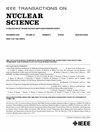Mechanism and Physical Model of the Single-Event Leakage Current for SiC JBS Diodes
IF 1.9
3区 工程技术
Q3 ENGINEERING, ELECTRICAL & ELECTRONIC
引用次数: 0
Abstract
The single-event leakage current (SELC) mechanism of the silicon carbide (SiC) junction barrier Schottky (JBS) diode is thoroughly investigated in this work. A comprehensive physical model to quantify the degree of SELC for the JBS diode is also proposed. From the collected experimental results, it is found that the leakage current of the SiC JBS diode increased with the increase in both the reverse bias voltage under irradiation and the total fluence. According to the results of the current response during irradiation and the emission microscope (EMMI) after irradiation, it can be inferred that the leakage current degradation of the samples originated from the accumulation of the Schottky junction’s area with a barrier reduction by the ion-induced local high temperature. Taking the degradation mechanism into account, a novel physical model is developed with the help of TCAD simulations. This model clearly highlights the relationship between the degradation (i.e., Schottky barrier height reduction and amplification of the leakage current) and the irradiation conditions (i.e., reverse bias voltage and fluence). This work provides valuable insights into the underlying origins of the SELC effect and its potential mitigation in SiC JBS diodes.SiC JBS 二极管单事件泄漏电流的机理和物理模型
本文深入研究了碳化硅(SiC)结势垒肖特基(JBS)二极管的单事件泄漏电流(SELC)机制。同时还提出了量化 JBS 二极管 SELC 程度的综合物理模型。从收集到的实验结果可以发现,SiC JBS 二极管的漏电流随着辐照下反向偏置电压和总通量的增加而增大。根据辐照时的电流响应和辐照后的发射显微镜(EMMI)结果,可以推断样品的漏电流劣化源于离子诱导的局部高温导致肖特基结的面积累积和势垒降低。考虑到降解机制,我们借助 TCAD 仿真建立了一个新的物理模型。该模型明确强调了降解(即肖特基势垒高度降低和漏电流放大)与辐照条件(即反向偏置电压和通量)之间的关系。这项研究为了解 SELC 效应的根本原因及其在碳化硅 JBS 二极管中的缓解潜力提供了宝贵的见解。
本文章由计算机程序翻译,如有差异,请以英文原文为准。
求助全文
约1分钟内获得全文
求助全文
来源期刊

IEEE Transactions on Nuclear Science
工程技术-工程:电子与电气
CiteScore
3.70
自引率
27.80%
发文量
314
审稿时长
6.2 months
期刊介绍:
The IEEE Transactions on Nuclear Science is a publication of the IEEE Nuclear and Plasma Sciences Society. It is viewed as the primary source of technical information in many of the areas it covers. As judged by JCR impact factor, TNS consistently ranks in the top five journals in the category of Nuclear Science & Technology. It has one of the higher immediacy indices, indicating that the information it publishes is viewed as timely, and has a relatively long citation half-life, indicating that the published information also is viewed as valuable for a number of years.
The IEEE Transactions on Nuclear Science is published bimonthly. Its scope includes all aspects of the theory and application of nuclear science and engineering. It focuses on instrumentation for the detection and measurement of ionizing radiation; particle accelerators and their controls; nuclear medicine and its application; effects of radiation on materials, components, and systems; reactor instrumentation and controls; and measurement of radiation in space.
 求助内容:
求助内容: 应助结果提醒方式:
应助结果提醒方式:


